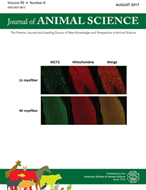-
Views
-
Cite
Cite
A. Brosh, Z. Henkin, E. D. Ungar, A. Dolev, A. Shabtay, A. Orlov, Y. Yehuda, Y. Aharoni, Energy cost of activities and locomotion of grazing cows: A repeated study in larger plots, Journal of Animal Science, Volume 88, Issue 1, January 2010, Pages 315–323, https://doi.org/10.2527/jas.2009-2108
Close - Share Icon Share
ABSTRACT
We determined the energy costs associated with the activities of beef cows grazing on Mediterranean foothill rangeland covered with herbaceous vegetation. Our central aim was to compare the energy cost coefficients obtained in this study, using relatively large plots, with those obtained in a previous study conducted on smaller plots. Measurements were performed in 3 seasons: in March on nursing cows grazing a 135-ha plot of high quality herbage (11.4 MJ/kg of ME), and in May and September on nonlactating cows grazing a 78-ha plot of low quality herbage (6.2 MJ/kg of ME). Poultry litter manure was given as a supplement in September. Stocking rates on the respective plots were 2.25 and 1.95 ha/cow; 5, 5, and 7 cows were monitored in the respective months. Heat production was determined by continuous monitoring of the heart rate and measurement of the oxygen consumption per heartbeat. Animal location was tracked with global positioning system (GPS) collars equipped with motion sensors. Activity was determined for 5-min intervals using suitable calibration equations. Horizontal and vertical distances traveled were computed by integrating GPS data and plot maps in a geographic information system. Three models were used to estimate the energy cost coefficients of engaging in a given activity and locomotion. Total daily heat production ranged from 644 (September) to 1,014 kJ·kg of BW−0.75·d−1 (March; P = 0.04). Estimates of the energy cost coefficients for activity states (kJ·kg of BW−0.75·d−1) ranged from 42.7 to 46.2 for standing, from 84.5 to 92.4 for walking idle, and from 89.4 to 103.2 for grazing; those for locomotion (kJ·kg of BW−0.75·d−1·km−1) ranged from 2.8 to 2.9 for horizontal locomotion and from 21.4 to 27.9 for vertical locomotion. Estimated cost coefficients of standing, grazing, and horizontal locomotion derived in the present study from animals on relatively larger plots were similar to those of the previous study based on data from smaller plots, but the energy costs of walking idle and of vertical locomotion were greater in the present study than in the previous one. The differences found are associated with the fact that cows in the present study walked for longer periods of time and traveled longer distances in single uninterrupted bouts of locomotion than those in the previous study.





